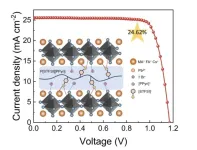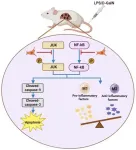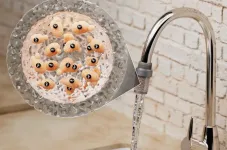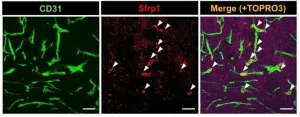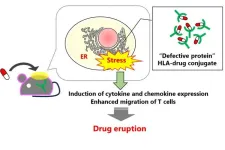(Press-News.org) Perovskite solar cells, which use materials with the same crystal structure as perovskite, are lightweight, flexible, easy to manufacture, and inexpensive. They can be attached to many different surfaces and are a promising technology. However, current perovskite solar cells are not durable, and they tend to be inefficient. New research shows how additive engineering with a polymerized ionic liquid to the metal halide perovskite material can improve the solar cell’s function, helping to pave the way for the future wide adoption of perovskite solar cells.
The research was published in Energy Materials and Devices on March 29.
“The commonly employed solution processing method for fabricating perovskite layers introduces many defects in both the bulk and surface of the perovskite layer. These intrinsic defects within the perovskite absorption layer pose a significant constraint on the overall performance of the devices. Additive engineering has been demonstrated to be effective as a strategy for defect passivation and performance enhancement in perovskite solar cells,” said Qi Cao, a researcher at Northwestern Polytechnical University in Xi’an, China.
To further improve the ionic liquids added to perovskite solar cells, researchers can create polymerized or poly ionic liquids. Polymers are added to ionic liquids, enhancing the properties of the ionic liquid. In this study, researchers synthesized a poly ionic liquid called poly4-styrenesulfonyl(trifluoremethylsulfonyl)imidepyridine, or PSTSIPPyri for short.
The addition of PSTSIPPyri to the metal halide perovskite solar cell has many benefits. It can prevent halide ion migration, which helps maintain the crystal structure, and facilitate the fixation of organic and halide ions, which improves the solar cell’s stability.
“To date, researchers have devoted considerable attention to the meticulous selection of additives that enhance the performance of perovskite solar cells. Among these, ionic liquids have received widespread attention. Ionic bonds in ionic liquids tend to be stronger and more stable, and they offer various tunable properties, including viscosity, polarity, and conductivity,” said Xuanhua Li, a researcher at Northwestern Polytechnical University. “This tunability makes it possible to fine-tune the ionic liquid properties to meet the specific requirements of the perovskite film, thereby optimizing device performance.”
To test the success of the addition of PSTSIPPyri, researchers conducted comprehensive studies of the perovskite solar cells with the poly ionic liquid, especially for factors that are essential for the performance of the solar cells. The perovskite films were aged for 300 hours at 85°C and 60% relative humidity. The enhanced perovskite film had a slower rate of change than the perovskite film with the poly ionic liquid. In a high humidity, high heat environment, it also maintained 84.5% of its efficiency after 1000 hours, while the control perovskite solar cell only maintained 43.6% of its initial efficiency.
Since perovskite solar cells are often less durable than alternatives, it was important to test the long-term durability of the perovskite solar cell with the addition of PSTSIPPyri. With the poly ionic liquid, the perovskite solar cell maintained 87.6% of its power conversion efficiency after 1,500 hours of continuous light, compared to the control which only maintained 61.1% of its power conversion efficiency.
“Incorporating PSTSIPPyri as an additive leads to a significant enhancement in the power conversion efficiency of inverted perovskite solar cells from 22.06% to 24.62%. They also demonstrate excellent long-term operational stability,” said Cao. “This strategy illustrates the potential of poly ionic liquids as a promising additive for perovskite solar cells, offering both high performance and stability.”
Other contributors include Xingyuan Chen, Tong Wang, Jiabao Yang, Xingyu Pu, Hui Chen, Bingxiu Xue, and Jianbo Yin at Northwestern Polytechnical University in Xi’an, China; Long Jiang at the CNPC Tubular Goods Research Institute in Xi’an, China.
The National Natural Science Foundation of China, the Science, Technology, and Innovation Commission of Shenzhen Municipality, the Shaanxi Science Fund for Distinguished Young Scholars, and the Open Project of State Key Laboratory of Supramolecular Structure and Materials supported this research.
About Energy Materials and Devices
Energy Materials and Devices is launched by Tsinghua University, published quarterly by Tsinghua University Press, exclusively available via SciOpen, aiming at being an international, single-blind peer-reviewed, open-access and interdisciplinary journal in the cutting-edge field of energy materials and devices. It focuses on the innovation research of the whole chain of basic research, technological innovation, achievement transformation and industrialization in the field of energy materials and devices, and publishes original, leading and forward-looking research results, including but not limited to the materials design, synthesis, integration, assembly and characterization of devices for energy storage and conversion etc.
About SciOpen
SciOpen is a professional open access resource for discovery of scientific and technical content published by the Tsinghua University Press and its publishing partners, providing the scholarly publishing community with innovative technology and market-leading capabilities. SciOpen provides end-to-end services across manuscript submission, peer review, content hosting, analytics, and identity management and expert advice to ensure each journal’s development by offering a range of options across all functions as Journal Layout, Production Services, Editorial Services, Marketing and Promotions, Online Functionality, etc. By digitalizing the publishing process, SciOpen widens the reach, deepens the impact, and accelerates the exchange of ideas.
END
LOS ANGELES — For adults with acute lymphoblastic leukemia (ALL), a type of cancer that originates in the bone marrow, allogeneic stem cell transplantation (more commonly known as a bone marrow transplant) may be necessary for survival. But for Hispanic patients, finding an identically matched donor within their family or through the bone marrow donor registry can be challenging, with only a 30% chance of finding a matching relative and a 48% chance of identifying a matching bone marrow donor through the national donor registry.
However, a new Keck Medicine of USC study in Leukemia ...
Everyone experiences aging in their own way, and factors such as genetics, lifestyle and environment play a role in this process. Some individuals reach the age of 90 or even 100 in good health, without medications or brain disease. But how do these individuals maintain their health as they age?
Luuk de Vries from Joost Verhaagen's group, and his colleagues Dick Swaab and Inge Huitinga, looked at brains from the Netherlands Brain Bank. The Netherlands Brain Bank stores brain tissue from more than 5,000 deceased brain donors with a wide range of different brain diseases. What makes the Netherlands Brain Bank so unique is that, in addition to the stored tissue with very precise ...
Background and Aims
Acute liver failure (ALF) is a life-threatening clinical problem with limited treatment options. Administration of human umbilical cord mesenchymal stem cells (hUC-MSCs) may be a promising approach for ALF. This study aimed to explore the role of hUC-MSCs in the treatment of ALF and the underlying mechanisms.
Methods
A mouse model of ALF was induced by lipopolysaccharide and d-galactosamine administration. The therapeutic effects of hUC-MSCs were evaluated by assessing serum enzyme activity, histological appearance, and cell apoptosis in liver tissues. The apoptosis ...
Washington, D.C.— May 15, 2024—A small number of New York City wild birds carry highly pathogenic H5N1 avian influenza, according to a recent study published in the Journal of Virology, a journal of the American Society for Microbiology. The work highlights that the interface between animals and humans that may give rise to zoonotic infections or even pandemics is not limited to rural environments and commercial poultry operations, but extends into urban centers.
“To my knowledge, this is the first large-scale U.S. study of avian influenza in an urban area, and the first with active ...
DALLAS, May 15, 2024 — Despite strides in cardiopulmonary resuscitation (CPR) training, consumer research from the American Heart Association reveals only 1 in 4 Asian American individuals are confident they could correctly perform Hands-Only CPR, compared with a comparable confidence rate of more 1/3 of the general population. The same survey showed nearly 70% of Asian American adults are hesitant to perform Hands-Only CPR because they are worried they will hurt the person who has suffered ...
CAMBRIDGE, MA – Every year, beer breweries generate and discard thousands of tons of surplus yeast. Researchers from MIT and Georgia Tech have now come up with a way to repurpose that yeast to absorb lead from contaminated water.
Through a process called biosorption, yeast can quickly absorb even trace amounts of lead and other heavy metals from water. The researchers showed that they could package the yeast inside hydrogel capsules to create a filter that removes lead from water. Because the yeast cells are encapsulated, they can be easily removed from the water once it’s ready ...
The National Foundation for Cancer Research proudly announces that our CEO, Dr. Sujuan Ba, was honored as one of the AAPI Women Leaders at the AAPI Women's Gala 2024 on May 14th in New York City. This prestigious event was hosted by The Serica Initiative to spotlight the outstanding achievements and contributions of Asian American and Pacific Islander (AAPI) women who are breaking barriers and making impacts in many sectors, enriching and adding value to our society.
This 8th year's gala, themed "Resilience and Perseverance," honored Dr. Ba for her exemplary leadership at NFCR and other organizations she is part of and her ...
A paper published in the CABI Reviews journal has found that climate change is the most prominent threat to pollinators – such as bumblebees, wasps, and butterflies – who are essential for biodiversity conservation, crop yields and food security.
The research, which is entitled ‘What are the main reasons for the world-wide decline in pollinator populations?’, suggests that many of the threats to pollinators result from human activities.
Pollinator populations are declining worldwide and 85% of flowering plant species and 87 of the leading global crops rely on pollinators for seed production. The decline of ...
Cancer is a leading cause of death globally. One of the primary reasons why cancer is such a deadly disease is the ability of cancer cells to become drug-resistant. After decades of medical research, scientists came to understand that malignant tumors often harbor a special population of cells called cancer stem cells (CSCs). Much like normal stem cells, CSCs can self-renew and differentiate into various cell types within a tumor, playing important roles not only in tumor growth and metastasis but also in the development of drug resistance.
Unfortunately, developing therapies targeting CSCs directly ...
Although medications can often help patients find a cure or respite from their condition, millions of people worldwide suffer from unpredictable drug toxicities every year. In particular, drug eruptions which manifest through symptoms such as redness, blisters, and itching on the skin, are quite common. Severe drug eruptions can become life-threatening and can have long-lasting consequences. Thus, understanding how and why drug eruptions occur is an important area of research in medical science.
To this end, previous studies have identified specific variants of certain genes as potential causal agents of drug eruptions. Scientists believe that ...
